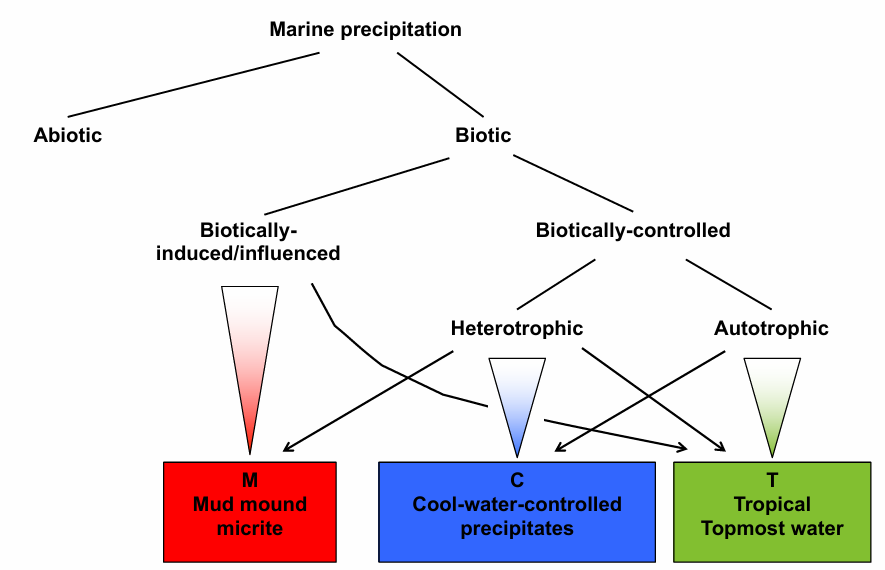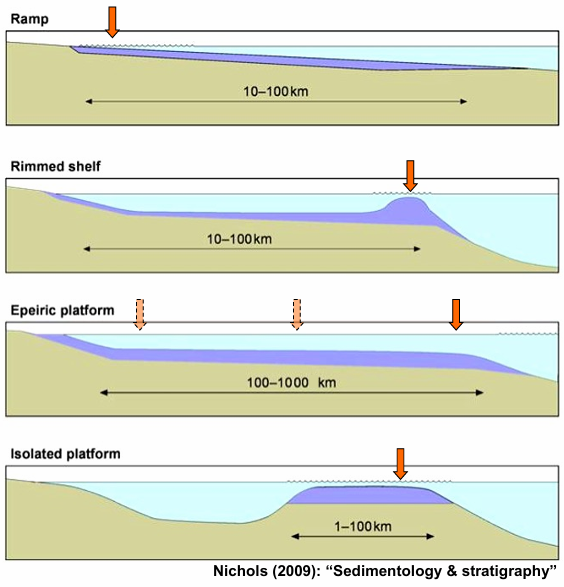Week 9 - Carbonate factory & carbonate platforms
1/17
There's no tags or description
Looks like no tags are added yet.
Name | Mastery | Learn | Test | Matching | Spaced |
|---|
No study sessions yet.
18 Terms
Subtidal carbonate factory
Driven by precipitated carbonate sediment in the shallow water due to high light levels and nutrients
Forms a shelf
Activity decreases with depth
What controls carbonate deposition in supersaturation (highest)
Abiotic control → high temperature, salinity and ocean restriction
Produces → Non skeletal grains, mud, microbes
What controls carbonate deposition in medium carbonate saturation
Biotically controlled (light as main energy source)→ High temperature, shallow depth, water transparency → affects productivity of photozoa (corals, green algae, symbiotic foraminiferas
Alternatively controlled by hydrodynamics and water transparency → production of red algae
What controls carbonate deposition in low carbonate saturation
Organic matter as main energy source → supply of plankton and other pelagic organic matter to the food chain → affects productivity of hereozoa
M,C,T production modes

Name the types of carbonate platforms
Ramp
Epeiric shelves
Rimmed shelf
Isolated platform

Average angle of repose in loose sediment, and what happens if it is exceeded
30-35 degrees
If exceeded the friction between grains is not strong enough to hold them together, so becomes unstable
Why do carbonates have a high angle of repose
Interlocking chemical precipitates form a skeletal framework rock (as opposed to classic granular sediment)
Mineralisation/cementation as supersaturated water passes through the pore space (degassing of CO2) which lithophies carbonates as they form
Presence of microbes
Features of a carbonate ramp
Shallow dipping often <1 degree
Subdivided based on the influence of waves/storms on sedimentation (Sedimentation in the mid ramp is frequently storm influenced)
Sand shoals sometimes form protection from wave/storm energy
Low energy basin with negligible storm influence
e.g Arabian-Persian Gulf

Features of a carbonate rimmed shelf
Shelf margin break (High organic productivity), reef growth or carbonate sand bodies
Ocean facing shelf margin -> high energy + turbulent
e.g the Bahamas

Features of a carbonate isolated platform

Features of carbonate Epeiric shelves
Deposited in epi-continental seas
Platforms < a few thousand kms wide
No modern as sea level is too low
Shallow water, storm influenced, intertidal sedimentation
E,g permian-cretacrous middle east
Key factors favouring carbonate production
Warm water
High salinity
isolated from influx of eroded sediment (terrigenous)
Depositional processes in high energy platform margins (reefs)
In situ growth of carbonate build up
Reworking by storms and currents
Export to basins by gravity processes
Depositional processes in oolitic sand shoals
In situ precipitation of ooids
Reworking by tidal currents, storms and waves
Depositional processes of (low energy) lagoons
Accumulation of faecal pellets from worms and gastropods
Disintegration of algae into mud
Chemical precipitation (whitings)
Depositional processes of land attached tidal flats
Reworking by tidal currents and waves
Storms move subtidal sediment onto tidal flat and into lagoon
Why are carbonates important to study
Carbonate precipitation is driven by carbonate factories in the shallow ocean so can be used to track sea level change over time
The distribution and character of lithofacies are controlled by characteristic environmental parameters and can be used to interpret ancient carbonate platforms